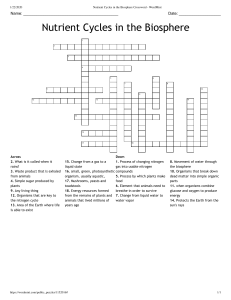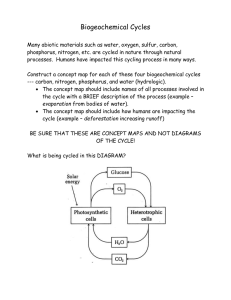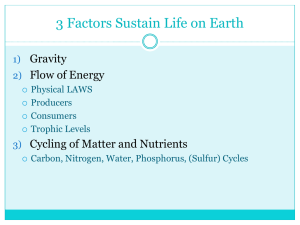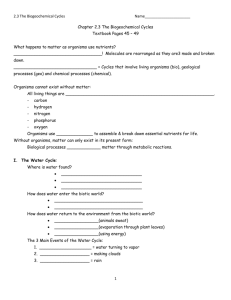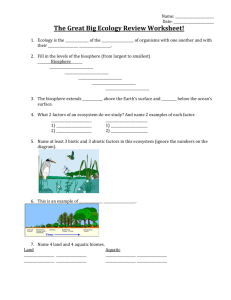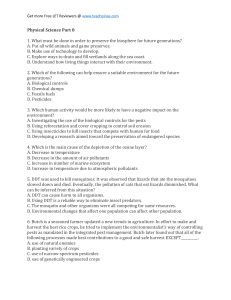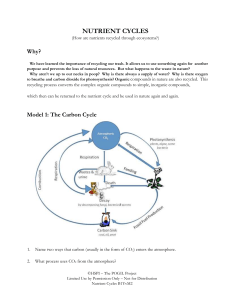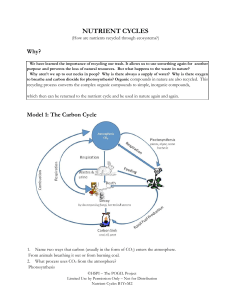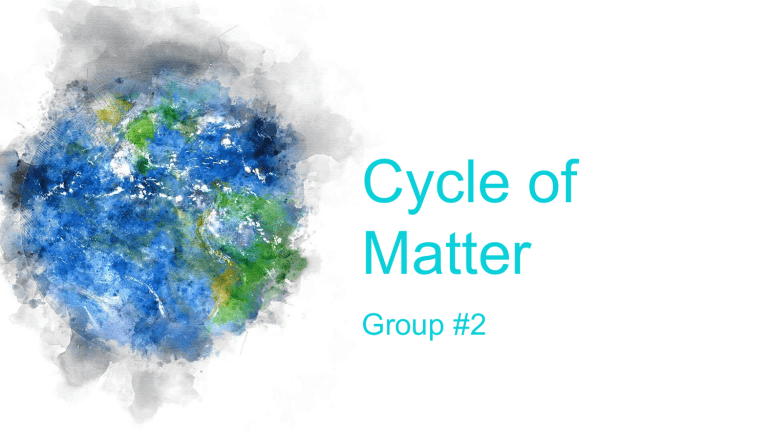
Cycle of Matter Group #2 Recycling in the Biosphere ⪢ Energy and matter move through the biosphere very differently. Elements, chemical compounds, and other forms of matter are passed from one organism to another and one part of the biosphere to another through biogeochemical cycles. ⪢ Matter can cycle through the biosphere because biological systems don’t use up matter, they transform it. 2 The Water Cycle Water molecule enter the atmosphere as water vapor, a gas, when they evaporate from the ocean or other bodies of water. The process in which water changes from liquid form to atmosphere gas is called evaporation. Water can also enter the atmosphere by evaporating from the leaves of plants in the process of transpiration. The water vapor condenses into tiny droplets that form clouds. When the droplets become large enough, the water returns to Earth’s surface as precipitation. Nutrient Cycles ⪢ The food you eat provides energy and chemicals that keep you alive. All the chemical substances that an organism needs to sustain life are its nutrients. 4 ⪢ Every living organism needs nutrients to build tissues and carry out essential life functions. Like water, nutrients are passed between organisms and the environment through biogeochemical cycles. The Carbon Cycle Carbon is a key ingredient of living tissue. Carbon and oxygen make up carbon dioxide. Carbon dioxide is taken by plants during photosynthesis and is given off by both plants an animals during respiration. Four main types of processes move carbon through its cycle: ⪢ Biological processes ⪢ Geochemical processes ⪢ Mixed biogeochemical processes ⪢ Human activities 5 6 The Nitrogen Cycle All organisms require nitrogen to make amino acids, which in turn are used to build proteins. Nitrogen gas is the most abundant form of nitrogen on Earth, only certain types of bacterias can use this form. 7 This bacterias convert nitrogen gas into ammonia in a process called nitrogen fixation. When organisms die, decomposers return nitrogen to the soil as ammonia. 8 Phosphorus Cycle Phosphorus is essential to living organisms because it forms part of important life-sustainig molecules such as DNA and RNA. Some phosphate stays on land and cycles between organisms and soil minerals. Phosphate is released when the rocks and sendiments gradually wear down. 9 10 Nutrient Limitation Ecologists are often interested in the primary productivity of an ecosystem, which is the rate at which organic matter is created by producers. When an ecosystem is limited by a single nutrient that is scarce or cycles very slow, this substance is called a limiting nutrient. Thanks for your attention 12
